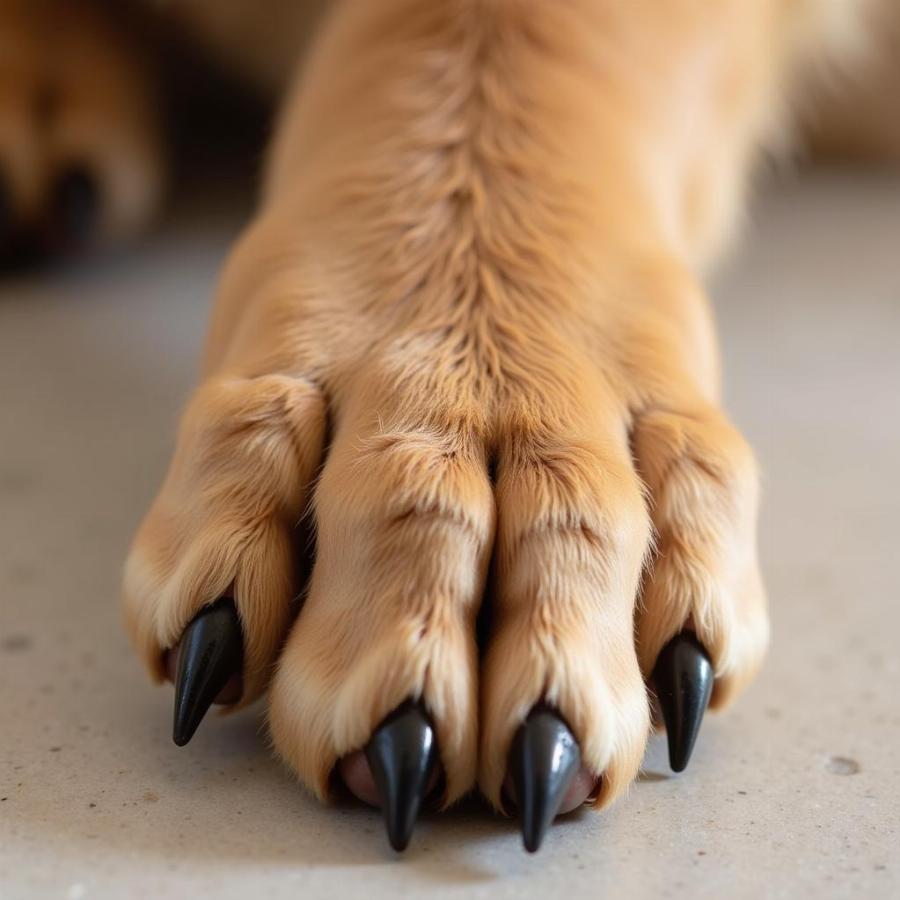Double dew claws on dogs, those extra toes higher up on their legs, often spark curiosity and questions among dog owners. Are they normal? Do they need to be removed? This article dives deep into the world of double dew claws, exploring their purpose, potential issues, and proper care.
What are Double Dew Claws?
Dew claws are essentially the dog’s “thumb,” a vestigial digit located on the inside of the paw, similar to our thumbs. While many dogs have single dew claws on their front legs, some breeds, particularly working and herding dogs, possess double dew claws, meaning they have two extra toes on each front leg.  Dog with double dew claws These double dew claws are considered a breed characteristic in some cases, contributing to improved grip and stability, particularly in mountainous or snowy terrain.
Dog with double dew claws These double dew claws are considered a breed characteristic in some cases, contributing to improved grip and stability, particularly in mountainous or snowy terrain.
The Purpose and Function of Double Dew Claws
So, why do some dogs have double dew claws? dogs with double dew claws originally used them for added traction while climbing, turning, and navigating uneven surfaces. Think of them as built-in crampons! They’re particularly advantageous for working breeds that need to grip livestock or objects. Imagine a herding dog making a sharp turn – those double dew claws help prevent slipping and maintain balance.
Benefits for Working Dogs
For dogs engaged in activities like herding, agility, or search and rescue, double dew claws can be a valuable asset. They provide additional stability and grip, allowing for more precise movements and better control. This is especially true in challenging environments where surefootedness is essential.
Potential Problems with Double Dew Claws
While double dew claws can be beneficial, they can also pose potential health risks. They’re prone to injury, especially if they become snagged on objects or during rough play. The claws can also grow excessively long and curl inward, digging into the skin and causing pain. Infection can also occur if the claw is torn or injured.
Why are Double Dew Claws Prone to Injury?
Double dew claws are located higher on the leg and aren’t as strongly attached as the main toes, making them more susceptible to catching and tearing. They also don’t experience the same wear and tear as the other claws during regular walking, leading to overgrowth.
Care and Maintenance of Double Dew Claws
Regular care is essential to prevent problems with double dew claws. dogs with back dew claws require trimming their dew claws regularly, just like their other nails. Keeping the claws short will reduce the risk of injury and infection. It’s important to check the dew claws frequently for any signs of damage, such as redness, swelling, or discharge.
How Often Should Double Dew Claws be Trimmed?
The frequency of trimming depends on the dog’s activity level and how quickly their nails grow. In general, most dogs need their dew claws trimmed every 2-4 weeks.
Dew Claw Removal: A Controversial Topic
The practice of removing dew claws, particularly in puppies, is a controversial topic. dog breeds with rear dew claws have them removed for cosmetic reasons or to prevent potential injuries. However, some argue that removing dew claws can negatively impact a dog’s gait and stability, especially in working breeds.
Is Dew Claw Removal Necessary?
The decision of whether or not to remove dew claws is best made in consultation with a veterinarian. They can assess the individual dog’s needs and advise on the best course of action.
Breeds Commonly Found with Double Dew Claws
Several breeds are known for their double dew claws, including the Great Pyrenees, Briard, Beauceron, and Icelandic Sheepdog. These breeds have historically worked in challenging terrains, and their double dew claws provide an evolutionary advantage.
Conclusion
Double dew claws on dogs are a fascinating anatomical feature with both benefits and potential drawbacks. While they can provide increased grip and stability, they also require careful attention and maintenance to prevent injury. By understanding the purpose, potential issues, and proper care of double dew claws, owners can ensure the well-being and comfort of their four-legged companions. Remember to consult with your veterinarian for any concerns about your dog’s dew claws.
FAQ
- Are double dew claws painful? Not typically, unless they become injured or infected.
- Can all double dew claws be removed? Yes, but it’s best to discuss the pros and cons with your veterinarian.
- Do double dew claws require special care? Yes, they need regular trimming and checking for injuries.
- Are double dew claws always present at birth? Yes, they are a congenital trait.
- Can double dew claws regrow after removal? No, they do not typically regrow after surgical removal.
- Are double dew claws more common in certain breeds? Yes, they are more prevalent in certain working and herding breeds.
- How can I tell if my dog’s double dew claw is infected? Look for signs like redness, swelling, discharge, or if your dog is excessively licking the area.
Further Reading
Are you interested in learning more about dog paws? Check out these related articles on our site:
Beaut Dogs: Your Trusted Source for Canine Information
Beaut Dogs is your one-stop destination for all things dog-related. We provide reliable and insightful information to help you understand and care for your canine companion. From breed characteristics to health and nutrition, we cover a wide range of topics to empower you to be the best dog owner you can be. For personalized guidance and answers to your specific questions, please contact us via Email: [email protected]. We’re here to help you navigate the wonderful world of dog ownership!